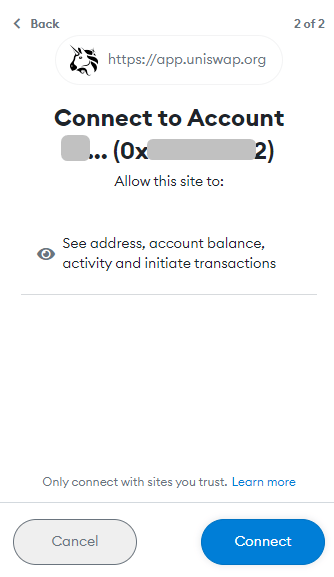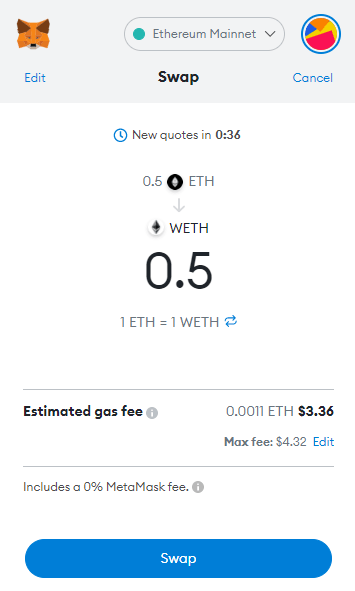Summary
The Ethereum Wedge Token (WETH) is a token pegged to the Ethereum (ETH) currency. WETH is used in many decentralized platforms and applications that support ERC-20 tokens. Although ETH is used to pay network transaction fees, it does not have the same functions as ERC-20 tokens.
You can easily convert ETH to WETH through a process known as pegging. You can also convert WETH back to ETH at any time. Both linking and unlinking follow a 1:1 ratio, meaning there are no costs other than transaction fees.
You can manually peg ETH by interacting with a WETH smart contract that will store ETH, and in return give you the exact same amount of WETH.
The DeFi ecosystem of the Ethereum network is large, and using WETH provides more opportunities for storage and investment. There are many versions of WETH, but some are more popular than others. You can also find ETH tokens tied to other blockchains for use in their ecosystems. Common uses for WETH tokens include trading non-fungible tokens, providing liquidity to liquidity pools, and lending cryptocurrencies.
the introduction
If you use the Ethereum network, most of the tokens you trade and invest likely use the ERC-20 token standard. This technical standard has become a popular choice in projects, wallets, and decentralized applications because it provides practicality for most users. But this fact poses a problem for the Ethereum network's native currency, Ethereum.
Ethereum does not follow the same rules as ERC-20 tokens, but there is demand for its use in decentralized ERC-20 applications as well. Ethereum pegged token is the solution to this problem, and you probably already know about it. Let's go over the reasons why this token has become a useful tool for investors and token holders in a wide range of decentralized projects and applications.
What is Pegged Ethereum (WETH) Token?
WETH is an ERC-20 token on the Ethereum network linked to the price of the Ethereum (ETH) coin. While Ethereum's native network token, ETH, can be used to pay processing fees, WETH cannot. But the use cases for WETH are much more than those for ETH, and WETH is very popular in the DeFi ecosystem. Additionally, MetaMask, TrustWallet, and almost any other wallet on the Ethereum network support WETH. Let's explore some of the use cases for this code.
Why do we need to peg ETH?
At first glance, it may seem confusing as to why we need a symbol like WETH. Don't we already have ETH on the Ethereum blockchain? The first thing to understand is that not every token on the Ethereum network is technically the same; The network allows developers to set new rules and standards for digital currencies.
An example of this is the ERC-721 format which gives us non-exchangeable tokens. These tokens work very differently than Ethereum or ERC-20 tokens. There is a lot of room for customization for developers as they create these digital assets. So while ETH can be used to pay processing fees on the Ethereum network, it cannot be used in all decentralized applications.
Most decentralized applications currently accept ERC-20 tokens in investment and storage opportunities. If we want to add ETH to a liquidity pool or use it as collateral, it is much easier for it to be an ERC-20 version. This version provides the greatest compatibility in the blockchain, and saves time spent creating new smart contracts.
How is Ethereum (ETH) pegged?
The process of generating a WETH token is simple; You send ETH to a smart contract that gives you a WETH token in return. This means that all WETH tokens generated are fully backed by ETH reserves. Your ETH is locked in the smart contract, and you can exchange it at any time for the WETH token. When ETH is returned, the contract burns the WETH token that was provided.
To peg Ethereum, you can directly interact with the WETH token smart contract so that it takes your ETH and adds the WETH token to your wallet at a 1:1 ratio (you still have to pay the transaction fee). Transferring back requires another interaction with the smart contract, but the method is almost identical.
However, it is easier to swap another token for WETH using a cryptocurrency exchange. Let's take a look at how you can swap ETH for WETH token using the decentralized trading platform Uniswap using the Metamask wallet.
Connect ETH on the Uniswap platform
1. Open Uniswap and connect your wallet. Make sure you also select Ethereum as your network.


2. Select ETH in the field at the top and WETH at the bottom. If you click [Select a token], you will see WETH above the list.

3. Enter the amount of ETH you want to convert to WETH and click the [Swap] button.

4. You will need to confirm the transaction in your cryptocurrency wallet. Don't forget that you will also need to pay a processing fee, so make sure you have extra ETH. Check the transaction details and click [Confirm].

5. All you have to do now is wait for the transaction to be confirmed in the blockchain. The waiting time will depend on the current intensity of network usage. If you're in a hurry, you can expedite the transaction (this will involve paying a higher fee) to confirm the transaction faster.
Connect ETH to MetaMask wallet
1. Open your MetaMask wallet and make sure your network is [Ethereum mainnet]. Next, click [Swap].

2. In the [Swap for] field, search for Search for WETH.

3. Enter the amount of ETH you want to swap and click [Review Swap].

4. You will now see a quote showing the conversion price (it should be 1:1). Click [Exchange] to finalize your transaction.

How to unpeg Ethereum (WETH) token?
As mentioned earlier, you can manually unpeg the pegged Ethereum by interacting with a smart contract. But it is easier and safer to swap WETH for ETH. To do this, follow the previously described instructions for your Uniswap or MetaMask wallet, but make sure to change from WETH to ETH. You can also use Binance to transfer your WETH tokens.
1. Go to the Binance portal to transfer and trade off-platform. Select WETH in the [From] field and ETH in the [To] field, then click [Preview Transfer].

2. You will now see the details of the trading process. Be sure to confirm the details before accepting the exchange. Please note that Binance does not allow you to swap ETH for WETH using this method.
How can ETH be linked to other blockchains?
Other pegged versions of ETH exist on many major blockchains, increasing ETH's interoperability. Using an ETH token pegged on the BNB Smart Chain (BSC), for example, allows you to trade or use WETH tokens within the BSC Chain DeFi ecosystem. To do this, you need to withdraw ETH from Binance or any other trading platform to your wallet on the BSC chain. Make sure the trading platform you are using supports conversion from ETH to WETH before making a withdrawal.
Alternatively, you can use a transfer service. Transfer services are third-party decentralized applications that take digital currency, store it on the original blockchain, and then mint the staked tokens 1:1 on the target blockchain.
Transferring tokens usually works well, but please be aware that transferring tokens across blockchains may involve risks. There are cases where smart contracts for some transportation bridges are compromised. So if you want to transfer pegged Bitcoin, pegged Ethereum, or any other token, carefully research the platform you will be using before using transfer services.
How does the price of a pegged ETH token remain equal to the price of ETH?
The secret to keeping the WETH token tied to the ETH token is 1:1 convertibility. If the WETH token is cheaper, people will buy it and convert it to the more expensive ETH token in order to make a profit. This opportunity increases the demand for WETH, and thus its price. If WETH is more expensive, people will buy ETH and convert it into WETH to sell, increasing the supply of WETH and reducing its price. These principles of supply and demand ensure that the connection remains relatively stable.
What DeFi applications can I use WETH tokens in?
There are several decentralized applications for Ethereum that accept ERC-20 tokens that can be explored. One option is to add WETH to a liquidity pool available on a decentralized trading platform such as Uniswap. By supplying liquidity, you can start earning fees from users who swap using the pool. But a non-permanent loss is a permanent potential risk that could result in the amount of your deposited tokens being reduced. But using a pool that includes larger amounts of liquidity reduces this risk.
You can also start lending WETH tokens on a platform like Aave. Other users can also borrow your tokens, but they must first provide collateral to cover what they borrow. In return, you will receive interest until you decide to remove your deposit.
Conclusion
Ethereum is one of the oldest and most advanced decentralized finance ecosystems. This makes WETH tokens essential, because many ETH token holders want to use ETH in DeFi projects. If you decide to start experimenting with WETH tokens, we recommend that you buy them for ETH or other tokens, as this is simpler and easier than interacting with peg smart contracts.









